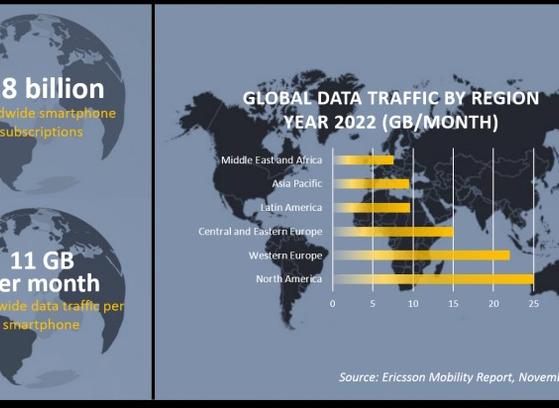The increasing device diversity makes it harder to understand the user experience perspective.
 User experience matters and it's something that MNOs have to pay particular attention to. Indeed, at last year's IMS World Forum, one of the speakers noted that this area, while crucial, it is often overlooked. How can you understand how your services are performing if you can't understand how your customers experience them?
User experience matters and it's something that MNOs have to pay particular attention to. Indeed, at last year's IMS World Forum, one of the speakers noted that this area, while crucial, it is often overlooked. How can you understand how your services are performing if you can't understand how your customers experience them?
Of course, it's hard to measure user experience at scale, since it has many subjective elements. However, since users experience services through their devices, the performance of such devices becomes a useful proxy for the experience enjoyed (or otherwise) by the user. Gathering objective information on device performance provides an excellent way to estimate real user experience.
Yet, one of the challenges that MNOs must prepare for in 2016 is an increasingly diverse device fleet. There are more manufacturers, more models and more versions of software. Each of these has different capabilities. Through time and especially as VoLTE deployments gather pace, more devices that support the requisite VoLTE and IMS client capabilities will be delivered — for example, while today there are more than 3200 LTE devices, only around 200 of these are VoLTE capable. What's more, there will be more and more versions of VoLTE client software, with the inevitable differences in performance.
The problem is likely to get worse as, not only will there be more IMS / VoLTE capable devices entering the market, there is also significant momentum behind the trend of Bring Your Own Device (BYOD) and a growing grey market in devices that bypass traditional GSMA approval processes. With BYOD, more and more users will acquire their own devices and bring them to MNO networks when they churn from a rival, or users will switch to them when they have no contract.
BYOD will also be driven by an increasing trend away from classical handset subsidization tactics. MNOs are trying to reduce the vast outlay on handset subsidies in a bid to reduce costs and boost profit. According to recent research, handset subsidies reached a peak in 2013 and are set to decline for the rest of this decade. Overall, the mix of devices, operating systems and clients will change rapidly — which will make it increasingly difficult to understand the user experience accurately.
The net impact of this is that, not only will MNOs have to cater for new emerging handsets and device upgrades from known vendors that are supposed to deliver IMS and VoLTE support, but they must also cope with an influx of unknown devices. Despite this, MNOs need to be able to understand the user experience as they deploy and launch services today, VoLTE or otherwise, on an IMS core. What's more, they must be able to do so even while devices are scarce, in order to reduce time to market.
It is essential, therefore, that operators can verify service performance from the perspective of users and their devices, they must also be able to anticipate growing future diversity in terms of devices that will enter their network.
They need to be able to accurately evaluate how devices perform when accessing different services, when they are situated in different parts of the network — in fact, a wide range of functional tests needs to be performed, so that MNOs can understand device behavior, service performance and obtain insight into customer experience. Of course, this is highly relevant from the user experience perspective, as the growing diversity of devices means that there isn't a single user experience, but many.
Because of this, MNOs need to be able to test with as many devices as widely as possible, and to ensure that complete services are involved in the program. However, just as we can expect there to be future issues with handset and device diversity, during this phase of the life cycle of IMS and VoLTE, we can also expect there to be issues in the availability and accessibility of compatible devices.
We already know from our own experience that some operators have reported several problems in this regard. First, a general lack of devices to test and, second, many of those that are generally configured for a specific VoLTE network and cannot simply be used for testing in another without a higher risk of failure. Worse, there is also a risk that operators spend time troubleshooting the VoLTE client, not the network and services with which they are really concerned.
Such issues delay service launch and, potentially, lead to poorly and inadequately tested services being activated. This costs time, money and, potentially, leads to a poor user experience at a key moment of truth. Users that experience poor service performance are more likely to be dissatisfied, more likely to churn and, worse, more likely to tell their peers about their negative experience, either directly or through social media channels.
So what's an MNO to do? The answer is to adopt a dual strategy of testing with virtual and physical devices using automated test platforms that can both encompass a wide diversity of devices and dramatically reduce the duration of test periods, accelerating time to market and ensuring that key milestones can be met — and, critically, enabling the collection of objective data that provides real, evidence-based information that allows the user experience to be measured.
GSA, June 2015
Strategy Analytics, July 2014, “Global Handset Subsidy Forecast by Region and Country, 2011 — 2022”
Plan just-in-time RAN expansions based on providing the targeted customer experience KPIs, saving considerable CAPEX;
Prioritize RAN investments, and avoid investing in areas that are providing adequate service;
Strategize for spectrum acquisition and spectrum re-farming based on meeting customer experience targets, not network element threshold KPIs.










